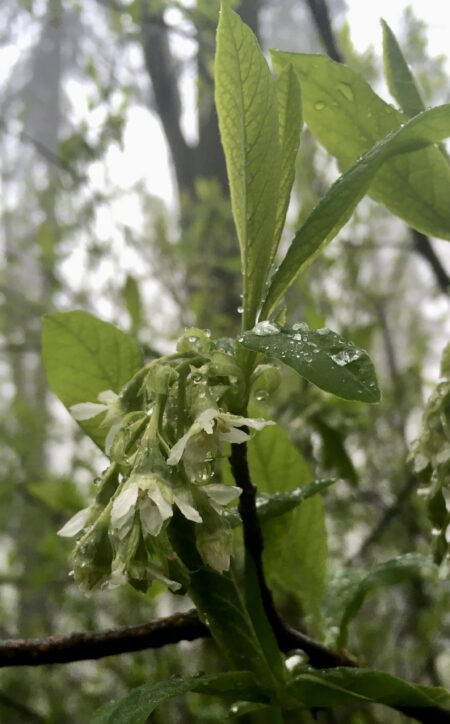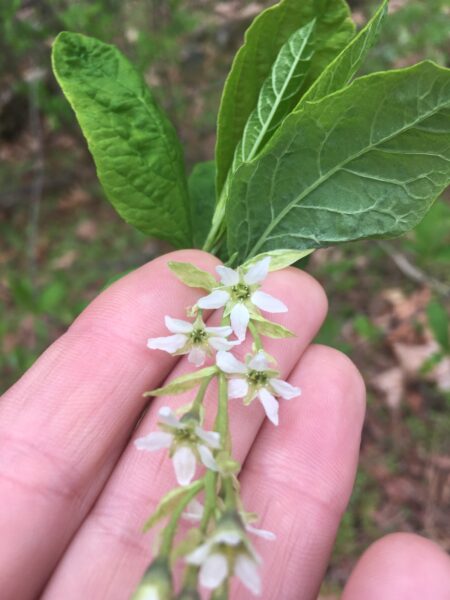As Courageous as Osoberry
March 13, 2023

There’s only a few plants of which I’d say, “Everyone needs this!” In the interest of diversity, and to keep my work new and engaging for myself, as well as for my clients, I don’t repeat plant palettes. However, almost every garden has a dark pocket of dry ground, that tough spot of gloom and dust. Such a spot is like March, when you crave the lightening of winter’s dark. Osoberry solves both these common malaises.
Previously known as Indian plum (one client sensitively tweaked this to ‘Kalapuya plum’), or botanically as Oemleria cerasiformis, Osoberry is the first native shrub to leaf out in late winter. By March, forests glow with its radiant green, sparkling with blooms.
Last year, I learned how to identify the male flowers from the female. Each grow on a separate plant, the one provides pollen and the other ripens into plum-like fruits. It became an obsession, or, more accurately reflecting the mood of it, a meditation—stopping at each flowering plant, grasping slender twig, gently twisting the down-turned blossomed to better see the mysteries they contained.
This month, I’m at it again. Osoberry is later to leaf and bloom than last year when it was my February plant of the month. It seems that the first to flower are the pollen-bearing plants. Each I’ve spied so far is decorated with a number of small clusters of pollen arrayed around the rim where the base of the petals meet their green anchor cup. The females will look different, with a few central beads, receptive and chartreuse, emerging from the center of smaller, whiter dots. It’s subtle, fascinating, a fun thing to share with kids. Check out Echo Valley’s pictorial resource and then go for a walk.
Is Osoberry in your garden? I know I’ll be adding some to bring height and complimentary bloom time with my hellebores. Until then, I head up the north side of Skinner’s Butte to get a closer look.

In like a lion, out like a lamb?
Still scraping morning ice off windshield,
rain becomes snow,
fingers bloodless numb.
What kind of lion comes in
with such blue chill?
A lion is the sun,
radiant, confident,
golden warm.
This March is coming in like a hungry rat:
biting, fierce,
invasive gray.
My smile lies heavy on my face,
my voice as clouded as the sky,
as my mood.
Until,
I ascend the butte
and look closer:
reliable signs from nature
of green hope
of emergence,
of change.
“How do we see the world as sacred again? By radical noticing.”
We laughed at this,
proclaimed mockingly,
how we were “radically noticing”:
the tree bark,
the seatbelt,
the colors of the houses,
the dog peeing.
But,
I know it’s truth.
Attention is a sacred thing.
Osoberry’s green vibrance
radiates like a lion
through the understory.
Peering into the
pendant white blooms,
seeking the pattern of anthers or stigma,
closer, deeper,
radical noticing.
From curiosity, wondering
are you male or female?
Pollen bearing or fruit forming?
And I am healed.
Making it sacred,
makes it healing.
Smile softens,
the day is hopeful and full of purpose again.
Not from the energy of the sun,
not directly.
But from small flowers holding sun,
radiating it’s joy in miniature,
a portal
for you
willing to look.

how does it do with voracious deer?
Well, they would voraciously enjoy eating its tender spring greens, yes indeed, tasty stuff. If you could protect it until it grows taller than their browsing it could grow into a lovely arching umbrella, but a young plant would be vulnerable. Deer are a real challenge if you want to plant mostly natives. I tend to expand the palette to include other stalwart, climate adapted plants in deer country.
Thank you for your musings on Osoberry! I too enjoy them at a time when it seems that spring will never arrive, and they encourage me with their buds, shoots and then flowers that spring is just around the corner. Several years ago I also learned how to identify male and female flowers of Osoberry because I wanted to propagate a female shrub to grow in my yard. (This was from a friend’s garden, not in the wild.) It does become a bit of an obsession and a meditation at the same time to look at the flowers of each shrub you come across once you learn how to do this. I love to do this at Mt. Pisgah every year now.
One of my female Osoberry shrubs has been bearing fruit for a few years now, and I love to watch the Cedar waxwings devour the fruit. Also, suddenly there are Osoberry seedlings everywhere in my yard. Those are fun to identify too as their seed leaves have a unique shape.
Lovely, Mary! Thanks for sharing. I adore anything that brings Cedar waxwings. You and I are birds of a feather!